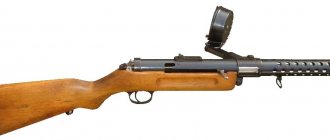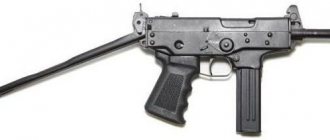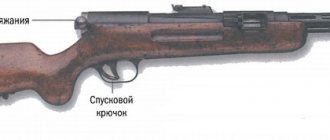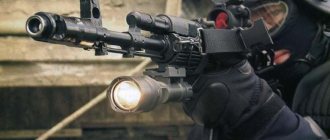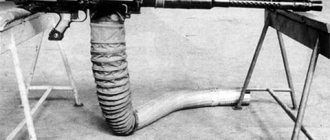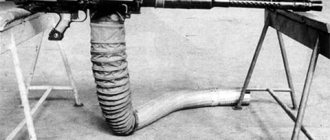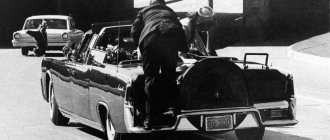PP Bison models
- Bizon-2B – modification with a silencer.
- PP 2 submachine gun chambered for 9×19 mm caliber cartridges.
- Bison-2-02 – 9×17 mm.
- Bison-2-03 had a caliber of 9x18 mm, and the suppressor equipment was integrated inside the pistol.
- Bizon-2-04 is another version of the self-loading Russian PP chambered for the 9x18 mm cartridge.
- Bison-2-05 is a self-loading submachine gun for use with 9×19 mm caliber cartridges.
- Bizon-2-06 is the third self-loading version of the Russian PP chambered for 9x17 mm cartridge.
- Bison-2-07. This version used 7.62x25 mm TT bullets. (When using 32-round box magazines, a handguard must be installed on the submachine gun).
- PP Bizon-3. This modification was supplied to the Ministry of Internal Affairs with a Kalashnikov assault rifle front sight. Additionally, it was possible to install a diopter sight on it. The weapon was equipped with a butt that folded upward. Also, this modification could be equipped with a silent firing device. A protrusion on the top of the receiver cocks the bolt.
The first in the line was the Bison 1 modification. The FSSP Bison submachine gun is equipped with a front sight, which was originally developed for the SVD. The first model has a mounted sight with three divisions at 50, 100 and 150 meters. The shutter cocking handle is located on the right. It is made of brown plastic.
The second modification goes on sale with a magazine upgraded for 9x18 PM and 9x18 PBM cartridges. The handle is installed from a Kalashnikov assault rifle of the hundredth model.
The Russian PP 19 was considered the best at that time, since it could be used in cramped spaces.
PPD-40.
0
Based on the combat experience of using the PPD-34/38 submachine gun in Finnish forests during the Soviet-Finnish War, the Red Army asked for several changes to its design, and in 1940 Degtyarev proposed a new model. The design was made with mass production and cost reduction in mind. Having abandoned the disk magazine of his own strange design, Degtyarev copied the Finnish Suomi store. At one time, he developed a disk magazine that was interchangeable with a regular box magazine, but now, since box magazines were abandoned, it became possible to significantly simplify the disc magazine and the neck for it. The new open-top disc magazine fit easily into the neck. But the PPD-40, well made from good materials, still remained a peacetime weapon. After the start of the Nazi invasion, the Russians, realizing what an intense struggle lay ahead of them, needed cheap weapons in huge quantities, and simpler designs replaced the PPD.
×
PPSh-41.
0
As a result of the German invasion of 1941, the Soviet Union lost enormous production capacity during its initial retreat. There was an acute labor shortage, and to arm the hundreds of thousands of recruits conscripted into the army, cheap weapons were required, easy to manufacture and handle, with sufficient firepower. The answer to this requirement was the PPSh (Shpagin submachine gun), created in 1941 by Georgy Shpagin. Its design was significantly simplified compared to previous Degtyarev models; The production process has become significantly shorter. The quality of the finish became rougher, but the barrel was still chrome-plated, and the effectiveness of the weapon was not in doubt. Partial disassembly for cleaning and maintenance was carried out extremely simply: the receiver cover together with the barrel rose forward on a hinge, opening the bolt and return spring. On later models, there was no fire selector: the submachine gun could only fire continuously. The magazine used was a tested and proven Suomi-type seventy-round disc magazine. The rate of fire was quite high, but the front part of the casing served as a simple compensator, preventing the barrel from moving upward when firing. By 1945, about five million PPSh submachine guns had been produced, and the Red Army developed infantry tactics for these weapons. Often entire battalions were armed only with submachine guns. At the end of the 50s, the PPSh was completely removed from service with the Soviet Army, replaced by the AK-47 assault rifle. However, this submachine gun was supplied in huge quantities to the satellites of the Soviet Union and to various pro-communist states. Also, the PPSh, with many minor changes, was produced in various countries of the Eastern Bloc and in Iran.
PPD-34/38.
0
See all photos in the gallery
PPD (Degtyarev submachine gun) is a general designation for several similar small arms systems produced in the Soviet Union from 1934 to 1940. The 34/38 model was in small quantities in service with the Red Army until 1940, when in addition to it the new PPD-40 model began to arrive, after which both were replaced by the PPSh-41. For its time, it was a fairly ordinary submachine gun, outwardly very similar to the German MP-28/II and the Finnish Suomi. The design of the mechanism is simple, but the submachine gun was expensive to manufacture, since the parts were made of high-quality steel by milling and turning; There were no stamped parts in the design. The neck for the magazine with a capacity of twenty-five rounds was located at the bottom; there was also a disk magazine of an unusual shape with a protruding tongue of complex design, necessary to insert the magazine into the neck like an ordinary box-shaped one. For the first time in a Soviet-made weapon, a disk magazine was used, which later (albeit in a slightly modified form) became common for all Soviet submachine guns with the exception of two. Of course, the standard Soviet 7.62 mm pistol cartridge was used as ammunition. The relatively light bullet flew out of the muzzle with a high initial velocity. However, increasing the muzzle velocity did not increase efficiency compared to the 9 mm Parabellum cartridge and did not increase the firing range. A notable feature of this submachine gun - as well as other Soviet models - was the chrome plating of the barrel. This expensive process was very popular among Soviet gunsmiths, since this treatment significantly increased the service life of the barrel in conditions of the rather careless attitude towards the weapons of recruits conscripted into the army in wartime.
Tactical and technical characteristics (TTX) of the Bison pistol
| Model | Caliber | Total length mm | Barrel length mm | Empty weapon weight kg | Number of cartridges in the magazine |
| Bison 2 | 9x18 | 690/460 | 230 | 2,7 | 64 |
| Bison 2-01 | 9x19 | 690/460 | 225 | 2,9 | 53 |
The rate of rounds per minute of the second modification of the submachine gun, according to the performance characteristics of the Bison PP, is 680 rounds per minute. And in the modernized version, the rate of fire became 750 rounds per minute. However, the new model's magazine has become less capacious.

